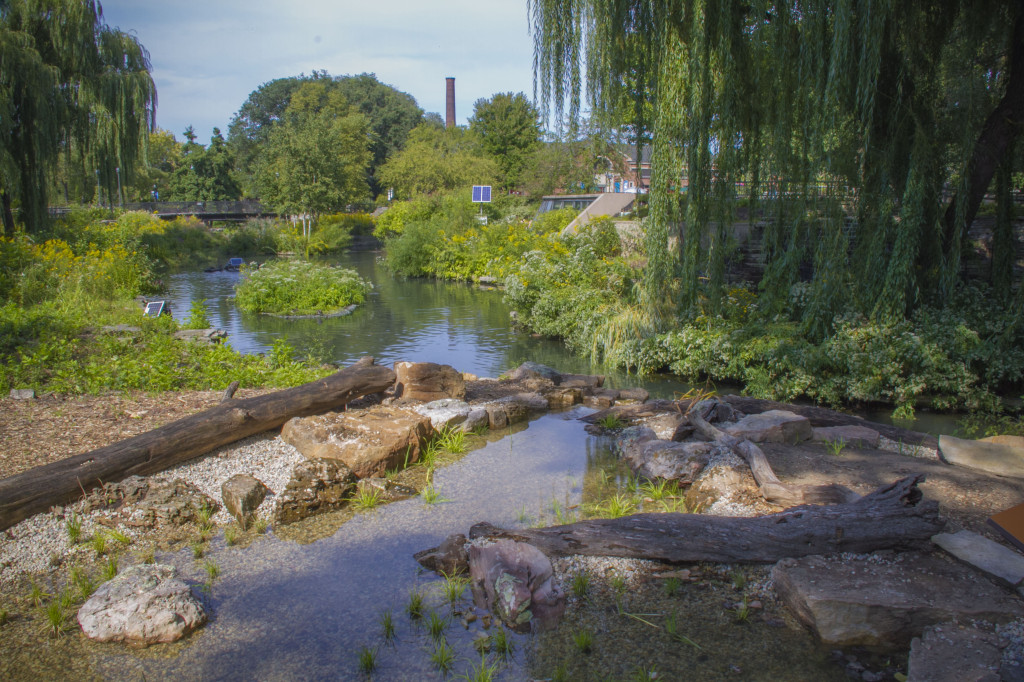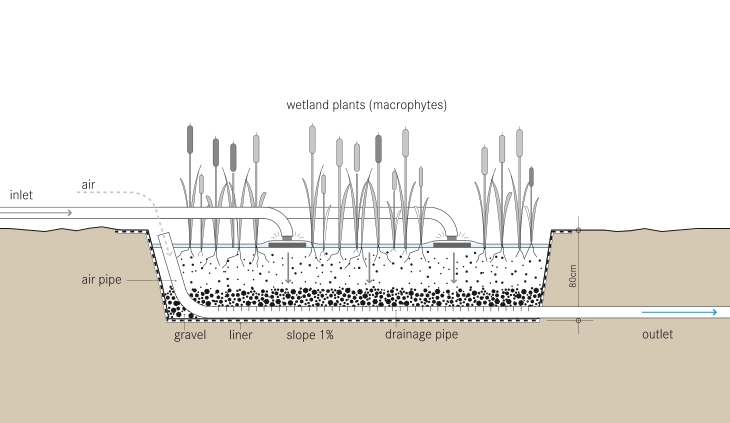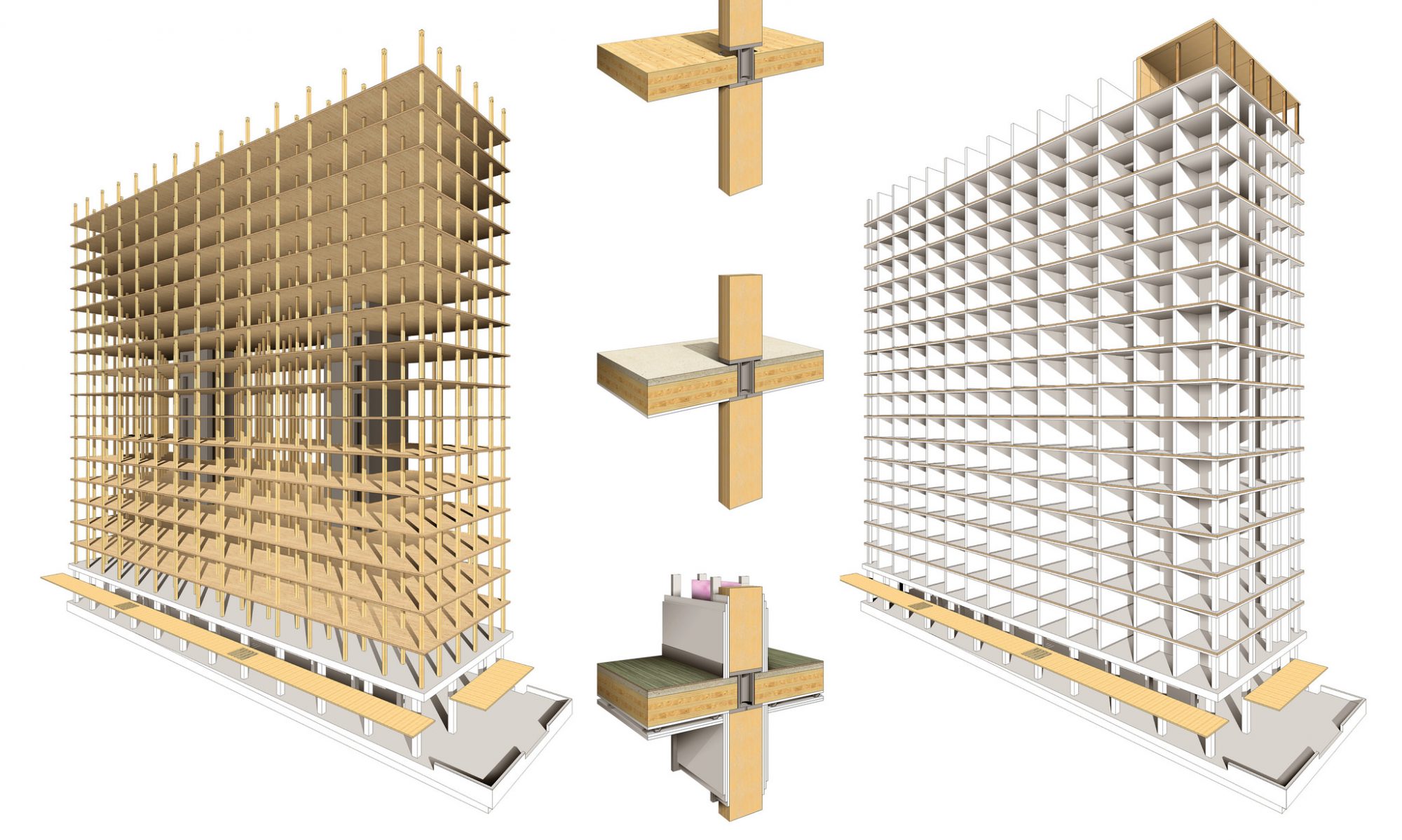This weeks learning, titled “Design for Water conservation and Waste-Water management” explored how the ecosystem approach to urban infrastructure design required engineers to consider the whole water cycle. That allows us as engineers to build infrastructure that restores the natural balance of water in ecosystems. While much of the reading was highly applicable and interesting, I was particularly intrigued by the idea of constructed wetlands and decided to investigate this topic further.
 Above – A beautiful constructed wetland in action at the Lincoln Park Zoo in the USA. Source:http://www.acornponds.com/bog-filtration.html
Above – A beautiful constructed wetland in action at the Lincoln Park Zoo in the USA. Source:http://www.acornponds.com/bog-filtration.html
What is a Constructed Wetland?
Constructed wetlands are engineered systems that use natural functions of vegetation, soil, and organisms to treat different water streams. Depending on the type of wastewater that has to be treated the system has to be adjusted accordingly which means that pre- or post-treatments might be necessary.
Constructed wetlands can be designed to emulate the features of natural wetlands, such as acting as biological-filters or removing sediments and pollutants such as heavy metals from the water. Constructed wetlands sometimes serve as a habitat for native and migratory wildlife, although that is usually not their main purpose.
There are three main types of Constructed Wetland:
- Subsurface flow constructed wetland – this wetland can be either with vertical flow (the effluent moves vertically, from the planted layer down through the substrate and out) or with horizontal flow (the effluent moves horizontally, parallel to the surface)
- Surface flow constructed wetland
- Floating treatment wetland
Cost of Constructed Wetlands
Constructed wetlands are self-sustaining, and thus their lifetime costs are significantly lower than those of conventional treatment systems. Often their capital costs are also lower compared to conventional treatment systems. They do take up significant space, and are therefore not preferred where real estate costs are high. Overall, constructed wetlands are generally significantly cheaper than conventional treatment systems.
How do they Work?
A constructed wetland is an engineered sequence of water bodies designed to filter and treat waterborne pollutants found in sewage, industrial effluent or storm water runoff. Constructed wetlands are used for wastewater treatment or for greywater treatment, and can be incorporated into an ecological sanitation approach. They can be used after a septic tank for primary treatment, in order to separate the solids from the liquid effluent. Some CW designs however do not use upfront primary treatment.
Vegetation in a wetland provides a substrate (roots, stems, and leaves) upon which microorganisms can grow as they break down organic materials. This community of microorganisms is known as the periphyton. The periphyton and natural chemical processes are responsible for approximately 90 percent of pollutant removal and waste breakdown. The plants remove about seven to ten percent of pollutants, and act as a carbon source for the microbes when they decay. Different species of aquatic plants have different rates of heavy metal uptake, a consideration for plant selection in a constructed wetland used for water treatment. Constructed wetlands are of two basic types: subsurface flow and surface flow wetlands.

Above is an example Horizontal Subsurface Flow Constructed Wetland. Source: https://en.wikipedia.org/wiki/File:Tilley_et_al_2014_Schematic_of_the_Horizontal_Subsurface_Flow_Constructed_Wetland.jpg

Above is an example of a Verticale Subsurface Flow Constructed Wetland. Source: https://en.wikipedia.org/wiki/Constructed_wetland#/media/File:Tilley_et_al_2014_Schematic_of_the_Vertical_Flow_Constructed_Wetland.jpg
How well does this connect to this weeks reading?
The concept of Constructed Wetlands connects very well to our reading. The following are some key connections:
- An excellent use of innovative technologies.
- Provides a long term water management plan.
- Address both wastewater and stormwater concerns.
- A great example of the ecosystem approach – not only are constructed wetlands providing an ecosystem service to the human population (waste control), but they also create additional oxygen producing plants and provide a habitat for local birds and wildlife.
References:
Canada Mortgage and Hoursing Corporation – “Constructed Wetlands” https://www.cmhc-schl.gc.ca/en/inpr/su/waho/waho_008.cfm
USA Environmental Protection Agency – “Constructed Wetlands” https://www.epa.gov/wetlands/constructed-wetland
Water Canada – “Constructed Wetlands: How Cold Can You Go?” http://watercanada.net/2009/constructed-wetlands/
School of Environment Sciences, University of Guelph – “Constructed Wetlands” http://www.ces.uoguelph.ca/water/NCR/ConstructedWetlands.pdf
